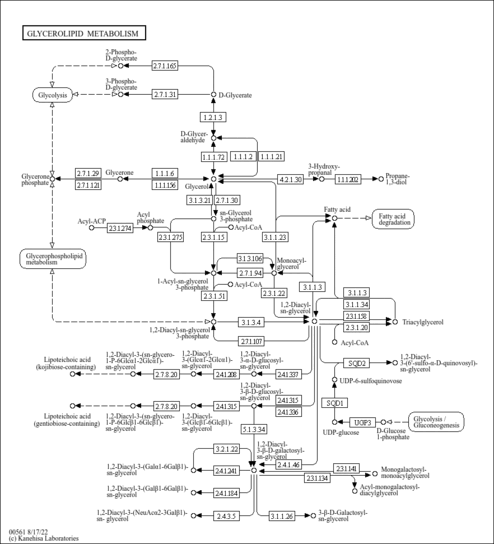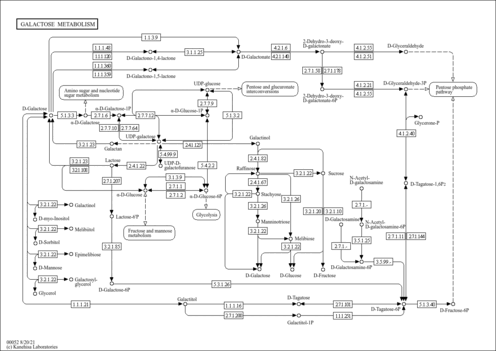| Record Information |
|---|
| Version | 1.0 |
|---|
| Created at | 2020-03-18 23:21:58 UTC |
|---|
| Updated at | 2020-12-07 19:06:56 UTC |
|---|
| CannabisDB ID | CDB006156 |
|---|
| Secondary Accession Numbers | Not Available |
|---|
| Cannabis Compound Identification |
|---|
| Common Name | Glycerol |
|---|
| Description | Glycerol, also known as glycerin or glycyl alcohol, belongs to the class of organic compounds known as sugar alcohols. These are hydrogenated forms of sugars in which the carbonyl group (aldehyde or ketone of the reducing sugar) has been reduced to a primary or secondary hydroxyl group. Glycerol is an extremely weak basic (essentially neutral) compound (based on its pKa). Glycerol or glycerin is a colourless, odourless, viscous liquid that is sweet-tasting and mostly non-toxic. It is widely used in the food industry as a sweetener and humectant and in pharmaceutical formulations. Glycerol is an important component of triglycerides (i.e. fats and oils) and of phospholipids. Glycerol is a three-carbon substance that forms the backbone of fatty acids in fats. When the body uses stored fat as a source of energy, glycerol and fatty acids are released into the bloodstream. The glycerol component can be converted into glucose by the liver and provides energy for cellular metabolism. Normally, glycerol shows very little acute toxicity and very high oral doses, or acute exposures can be tolerated. On the other hand, chronically high levels of glycerol in the blood are associated with glycerol kinase deficiency (GKD). GKD causes the condition known as hyperglycerolemia, an accumulation of glycerol in the blood and urine. There are three clinically distinct forms of GKD: infantile, juvenile, and adult. The infantile form is the most severe and is associated with vomiting, lethargy, severe developmental delay, and adrenal insufficiency. The mechanisms of glycerol toxicity in infants are not known, but it appears to shift metabolism towards chronic acidosis. Acidosis typically occurs when arterial pH falls below 7.35. In infants with acidosis, the initial symptoms include poor feeding, vomiting, loss of appetite, weak muscle tone (hypotonia), and lack of energy (lethargy). These can progress to heart, liver, and kidney abnormalities, seizures, coma, and possibly death. These are also the characteristic symptoms of untreated GKD. Many affected children with organic acidemias experience intellectual disability or delayed development. Patients with the adult form of GKD generally have no symptoms and are often detected fortuitously. |
|---|
| Structure | |
|---|
| Synonyms | | Value | Source |
|---|
| (+)-b-Irone | Generator | | (+)-Β-irone | Generator |
|
|---|
| Chemical Formula | C3H8O3 |
|---|
| Average Molecular Weight | 92.09 |
|---|
| Monoisotopic Molecular Weight | 92.0473 |
|---|
| IUPAC Name | (3E)-4-[(5R)-2,5,6,6-tetramethylcyclohex-1-en-1-yl]but-3-en-2-one |
|---|
| Traditional Name | (3E)-4-[(5R)-2,5,6,6-tetramethylcyclohex-1-en-1-yl]but-3-en-2-one |
|---|
| CAS Registry Number | 8043-29-6 |
|---|
| SMILES | OCC(O)CO |
|---|
| InChI Identifier | InChI=1S/C3H8O3/c4-1-3(6)2-5/h3-6H,1-2H2 |
|---|
| InChI Key | PEDCQBHIVMGVHV-UHFFFAOYSA-N |
|---|
| Chemical Taxonomy |
|---|
| Description | Belongs to the class of organic compounds known as sesquiterpenoids. These are terpenes with three consecutive isoprene units. |
|---|
| Kingdom | Organic compounds |
|---|
| Super Class | Lipids and lipid-like molecules |
|---|
| Class | Prenol lipids |
|---|
| Sub Class | Sesquiterpenoids |
|---|
| Direct Parent | Sesquiterpenoids |
|---|
| Alternative Parents | |
|---|
| Substituents | - Cyclofarsesane sesquiterpenoid
- Megastigmane sesquiterpenoid
- Sesquiterpenoid
- Ionone derivative
- Alpha,beta-unsaturated ketone
- Enone
- Acryloyl-group
- Ketone
- Organic oxygen compound
- Organic oxide
- Hydrocarbon derivative
- Organooxygen compound
- Carbonyl group
- Aliphatic homomonocyclic compound
|
|---|
| Molecular Framework | Aliphatic homomonocyclic compounds |
|---|
| External Descriptors | Not Available |
|---|
| Ontology |
|---|
|
| Physiological effect | Health effect: |
|---|
| Disposition | Route of exposure: Source: Biological location: |
|---|
| Role | Biological role: Industrial application: |
|---|
| Physical Properties |
|---|
| State | Solid |
|---|
| Experimental Properties | | Property | Value | Reference |
|---|
| Melting Point | 20 °C | Not Available | | Boiling Point | 290 °C | Wikipedia | | Water Solubility | 1000 mg/mL | Not Available | | logP | -1.76 | HANSCH,C ET AL. (1995) |
|
|---|
| Predicted Properties | [] |
|---|

